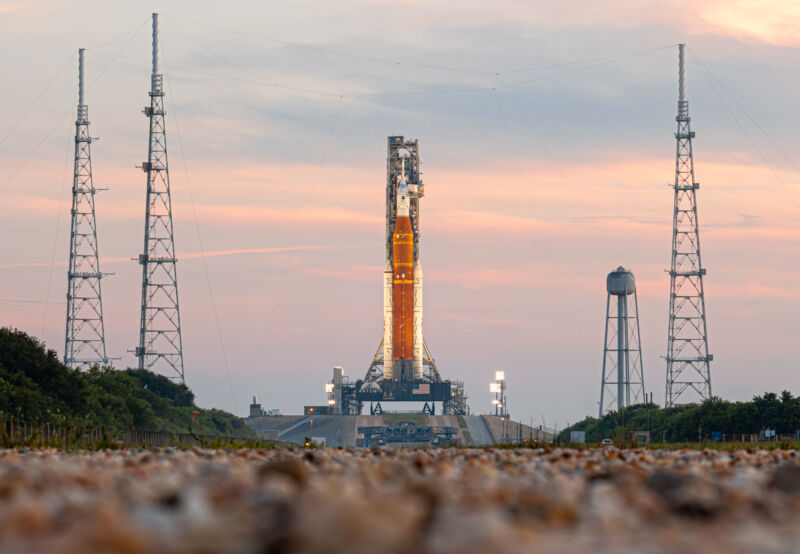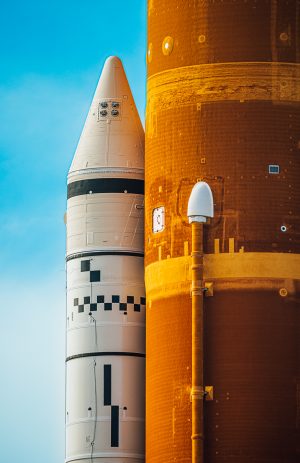
Trevor Mahlmann
President Eisenhower signed the law establishing the National Aeronautics and Space Administration on July 29, 1958. At the time, the United States had put about 30 kg of small satellites into orbit. Less than 11 years later, Neil Armstrong and Buzz Aldrin landed on the Moon.
President Obama signed a NASA Authorization Act on October 11, 2010. Among its provisions, the law called on NASA to create the Space Launch System rocket and have it ready for launch in 2016. It seemed reasonable. At the time, NASA had been launching rockets, including very large ones, for half a century. And in some sense, this new SLS rocket was already built.
The most challenging aspect of almost any launch vehicle is its engines. No problem—the SLS rocket would use engines left over from the space shuttle program. Its side-mounted boosters would be slightly larger versions of those that powered the shuttle for three decades. The newest part of the vehicle would be its large core stage, housing liquid hydrogen and oxygen fuel tanks to feed the rocket’s four main engines. But even this component was derivative. The core stage’s 8.4-meter diameter was identical to the space shuttle’s external tank, which carried the same propellants for the shuttle’s main engines.
Alas, construction wasn’t that easy. NASA’s SLS rocket program has been a hot mess almost from the beginning. It has been efficient at precisely one thing, spreading jobs around to large aerospace contractors in the states of key congressional committee leaders. Because of this, lawmakers have overlooked years of delays, a more than doubling in development costs to above $20 billion, and the availability of far cheaper and reusable rockets built by the private sector.
So here we are, nearly a dozen years after that authorization act was signed, and NASA is finally ready to launch the SLS rocket. It took the agency 11 years to go from nothing to the Moon. It has taken 12 years to go from having all the building blocks for a rocket to having it on the launch pad, ready for an uncrewed test flight.
I have decidedly mixed emotions.
Trevor Mahlmann
With the launch just days away, I am incredibly happy for the people at NASA and the space companies that have worked hard, cut through the bureaucracy, managed thousands of requirements, and actually got this rocket built. And I’m eager to see it fly. Who doesn’t want to watch a huge, Brobdingnagian rocket consume millions of kilograms of fuel and break the surly bonds of Earth’s gravity?
On the less happy side, it remains difficult to celebrate a rocket that, in many ways, is responsible for a lost decade of US space exploration. The financial costs of the program have been enormous. Between the rocket, its ground systems, and the Orion spacecraft launching on top of the stack, NASA has spent tens of billions of dollars. But I would argue that the opportunity costs are higher. For a decade, Congress pushed NASA’s exploration focus toward an Apollo-like program, with a massive launch vehicle that is utterly expended, using 1970s technology in its engines, tanks, and boosters.
Effectively, NASA was told to look backward when this country’s vibrant commercial space industry was ready to push toward sustainable spaceflight by building big rockets and landing them—or storing propellant in space or building reusable tugs to go back and forth between the Earth and Moon. It’s as if Congress told NASA to keep printing newspapers in a world with broadband Internet.
It didn’t have to be this way. In fact, a handful of visionary space policy leaders tried to stop the wastefulness but were beaten back by the defense industry and its allies in Congress.
For me personally, this is also the end of an era. In many ways, this rocket has mirrored my career as a journalist and writer covering the space industry. So as we approach this momentous launch, I want to tell the story—the real story—about where this came from and where it’s going. I will make the case that the SLS rocket is the worst thing, and perhaps simultaneously the best thing, to ever happen to NASA.
I believe this story can still have a happy ending.
The SLS rocket is the worst thing to happen to NASA—but maybe also the best? & Latest News Update
The SLS rocket is the worst thing to happen to NASA—but maybe also the best? & More Live News
All this news that I have made and shared for you people, you will like it very much and in it we keep bringing topics for you people like every time so that you keep getting news information like trending topics and you It is our goal to be able to get
all kinds of news without going through us so that we can reach you the latest and best news for free so that you can move ahead further by getting the information of that news together with you. Later on, we will continue
to give information about more today world news update types of latest news through posts on our website so that you always keep moving forward in that news and whatever kind of information will be there, it will definitely be conveyed to you people.
The SLS rocket is the worst thing to happen to NASA—but maybe also the best? & More News Today
All this news that I have brought up to you or will be the most different and best news that you people are not going to get anywhere, along with the information Trending News, Breaking News, Health News, Science News, Sports News, Entertainment News, Technology News, Business News, World News of this made available to all of you so that you are always connected with the news, stay ahead in the matter and keep getting today news all types of news for free till today so that you can get the news by getting it. Always take two steps forward
Credit Goes To News Website – This Original Content Owner News Website . This Is Not My Content So If You Want To Read Original Content You Can Follow Below Links
